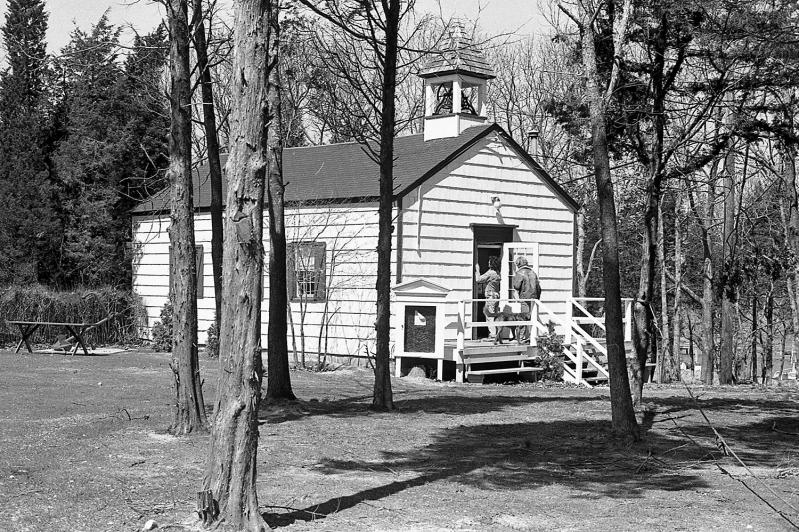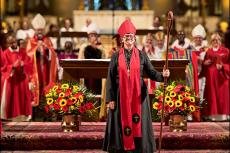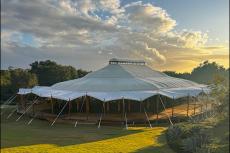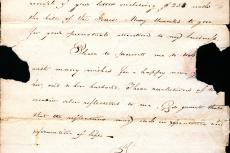Sixty-three years ago this past October, the Rev. Charles Ralph Spinner gathered the people of Calvary Baptist Church together, and, after leading the morning worship, led them on a roughly half-mile walk to what would be the church’s new, permanent home.
Reverend Spinner had come to East Hampton in 1954, after receiving in a vision from God an indication that he should “Go East and erect a temple in my name.” He found a place for his Baptist mission in a small, simple chapel that at the time belonged to St. Luke’s Episcopal Church, and whose leader, the Rev. Samuel Davis, offered it for a new meeting house of the faithful.
Though gone from where it had stood since being erected in 1852, the chapel remains intact and is now used as a fitness center at the East Hampton Point resort. There have been several halting attempts to have the building returned to a public place of prominence in the past decade. Until recently, any prospect of that had been hung up on an impasse between the new owner of East Hampton Point and town officials; however, that logjam has begun to move.
Throughout its life as a church, the little Freetown building was at the center of a multiethnic community.
Until his death in a plane crash along with his wife, a grandson, and the pilot, in 2018, Ben Krupinski, an East Hampton high-end builder, owned East Hampton Point and had from time to time been engaged with the town about having the chapel moved at his expense. After his death, his estate found a buyer in a group of investors led by Heath Freeman of Alden Global Capital, a Manhattan hedge fund of which Mr. Freeman is managing director. The fund has made headlines for a string of newspaper purchases that were followed by aggressive staff buyouts, selling the real estate, and deep cost-cutting measures.
Among Alden’s newspaper holdings have been The Denver Post, St. Paul Pioneer Press, San Jose Mercury News, Los Angeles Daily News, The Boston Herald, and The Chicago Tribune, for which it paid $630 million in May. Mr. Freeman and co. acquired East Hampton Point in March 2021 for about $18 million. In December, he bought an adjacent waterfront restaurant for $4 million. He and his wife, Jane Hegleman Freeman, have a house in Montauk.
Speaking of the chapel building on Tuesday, Michael Capoferri, the longtime general manager of East Hampton Point, said that “We are engaged in productive discussions with the leaders of the local community about the most meaningful ways to honor the important legacy of this historic site.”
This was welcomed by East Hampton Town Supervisor Peter Van Scoyoc, who said he had pursued the chapel’s return to public prominence for several years, with both the late Mr. Krupinski and the new owners. “I expect that we will be able to make an announcement soon,” he said.
Long before Mr. Freeman’s ownership, long before Ben Krupinski, long before Reverend Spinner preached there, and even long before it was called St. Matthew’s, the tiny chapel occupied an important place for three interrelated East Hampton communities — Indigenous, Black, and white. In this, it is one of the rare functionally integrated houses of worship on Long Island — and rarer still that the building endures, albeit as one now housing Peloton exercise bikes.
No single history gives account of how the Freetown Chapel came to be or how it served its corner of East Hampton Town from year to year. But from piecing together a little bit here, a bit there, something of a fuller picture emerges. The land off Three Mile Harbor Road on which the chapel would stand belonged to John and Lovina Walstein, according to an 1852 record of its sale. It was sold, to Mary R. Pell of Flushing, on the condition that a structure “suitable for and to be used for, a Sabbath School Room, for a place of Religious or Bethel meetings, and for no other purposes whatsoever,” be built upon it. The sale price was $1.
After its completion, for many years, nondenominational services were held there, conducted by various clergy and laypeople of the community. But Episcopal services at the chapel became less frequent over time. At some point, St. Luke’s acquired a bus to take worshipers to the mother church, and more families got automobiles, and the old building fell into disuse until Reverend Spinner arrived. The Episcopal Church’s last service at St. Matthew’s was on Christmas Day 1968.
Much more remains to be learned about who the Walsteins were as well as Mrs. Pell, who, it is said, paid for the chapel to be built out of her own pocket. Even locating the original site today is a challenge, but for someone who knows the area, it is on the left, a short walk north from Oakview Highway.
The real credit for saving the Freetown Chapel belongs to Dick Sage, the man who had the idea that it should be the centerpiece of a historical village at his East Hampton marina. In an unpublished memoir, he recounted how he had learned from two members of the local Black community, who had worked for him as masons, that it was going to be torn down. According to what they understood, St. Luke’s rector and board had determined in about 1974 that the building was a liability. Mr. Sage saw an opportunity, and in his memoir gave the only known detailed description of its layout.
The foundation was posts of locust wood, set on flat rocks three feet below the frost line. Thick layers of dried seaweed had been packed around the posts and inside the walls as insulation. There were gaps in the cedar-shingle roof. The front porch had slumped, and window panes were missing. The belfry, with its 20-inch brass bell, listed to the north and looked ready to fall. “It was a forgotten treasure neglected, abandoned and left to disintegrate on the threshold of demolition,” Mr. Sage wrote.
Inside, behind the last pew on the right, he saw a large cast-iron stove used for heat, with a rack for logs nearby. To one side, there was an 1860 made-in-Vermont organ, its bellows worn and rotted, but he was awed by the pristine condition of the hand-carved altar and cushioned communion rail. A modest stained-glass window bearing the date 1851 was at the rear. It was as if some mysterious spirit had protected this section of the chapel from the “elements of deterioration,” he wrote.
Initially, Mr. Sage tried to get town officials interested in moving the chapel to the Marine Museum on Bluff Road in Amagansett, but they balked at the idea, preferring not to dredge up any reminders of the town’s segregated past. He was told to forget it. That did not sit well. After securing the permission of the Episcopal Bishop for the region, building permits from the town were the next hurdle, which he eventually surmounted. In 1976, finally, a housemover placed the chapel on long steel I-beams for the move to its new foundation.
Throughout its life as a church, the little Freetown building was at the center of a multiethnic community. In the 1870 United States Census, Robert Montgomery, 25, Mary, 23, Julia, 2, Huldah, 1 month, and Philis Disberry, 91, lived in a small house to the north side of the chapel. Montgomery, who was Black, was born in Virginia and was listed as a farm laborer. Disberry, perhaps his mother-in-law, had been born there as well — during the time of slavery. On the south side of the chapel, William Cullum, a white blacksmith who was 43 in 1870, lived with his wife and children.
As reported in The Sag Harbor Corrector of Sept. 6, 1879, Stephen Pharoah, whom we know today as Stephen Talkhouse, died of consumption at the nearby home of his son-in-law Ben Coles. The Rev. J.D. Stokes preached his funeral sermon in the Freetown Chapel. Pharoah’s age was given as 58. In 1886, Nathan Lester, who was white, led the Monday-evening meetings at the chapel.
Over the years, many funerals were held there, including, in January 1916, one for Henry Theodore Bennett, 75, whom The Star called one of the few surviving veterans of the Grand Army of the Republic. “Mr. Bennett was buried from St. Matthew’s chapel,” the report said




